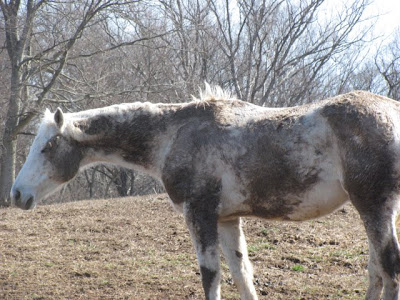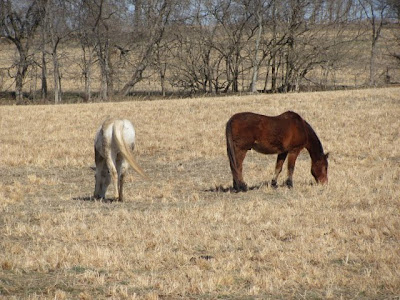Given that most people feed grain primarily to keep or add weight to their critters, knowing how many calories each pound of feed contained would be really handy, especially when one was trying to compare feeds....even those made by the same company....on an apples to apples basis. Unfortunately, companies are not required to place this information on feed tags so nobody does. It's been my experience that some companies are a lot more forthcoming with this sort of information than others are, but they will usually provide it to you if you call or email a request to them.
Sometimes, getting the numbers you need and comparing feeds based on energy levels leads to some interesting and counter intuitive results. I once had a case where Feed A and Feed B had nearly identical tag specs (which don't tell how much energy each feed might contain) but had markedly different prices. Of course, all things being equal, everyone went for the cheaper option which in this case was Feed B. However, the energy content of Feed B was so much lower than Feed A that Feed A actually worked out to be considerably cheaper to feed if one took the time to find out how much energy each feed contained. To strengthen this important point, let me highlight this with a hypothetical example.
Feed Required to Achieve 10,000 kcal from grain
Feed X - Price $ 12.00 per 50 lb bag - DE 1500 kcal/lb - 6.67 lbs - Cost - $ 1.44 per horse
Feed Y - Price $ 10.00 per 50 lb bag - DE 1000 kcal/lb - 10.0 lbs - Cost - $ 2.00 per horse
Hope folks found this helpful !
______________________________
Rampal leading Clayton and Johnny across the pasture (Gus and Asterik in the pasture behind them)
 Boo and Sebastian
Boo and Sebastian Gus and Faune
Gus and Faune Norman
Norman Rocky and Toledo napping with Kennedy and Stormy standing watch
Rocky and Toledo napping with Kennedy and Stormy standing watch Wiz enjoyed a good roll . . .
Wiz enjoyed a good roll . . . . . . and got up looking like a pinto
. . . and got up looking like a pinto Lucky and Spike
Lucky and Spike Lightening rolling with Lucky grazing
Lightening rolling with Lucky grazing Noble and Snappy
Noble and Snappy Toledo, Rocky, Johnny and Stormy
Toledo, Rocky, Johnny and Stormy



6 comments:
You would think manufacturers of grains like Feed A would want to promote the fact that you could feed less for the same amount of energy amnd therefore less money than "competitors." If they don't care about being informative for it's own sake, surely they care about increased sales!
These are such valuable things to know and think about, thank you for posting!
I go through the same thing with dog food, actually. I like to know the actual Kcals per unit for my own dog but especially for the foster dogs. They all have their own particular issues (usually skinny and/or sick, only one was severely obese) so it helps to be precise. Not to mention where the energy comes from. If a company refuses to provide the info via phone call or email, I won't feed that food, plain and simple. I find calling gets better results, for some reason.
Very good point - sometimes price means something. I wish feed manufacturers would put all this information on the label, as well as NSC values.
Great post. I'm glad to know there's a way to make those comparisons. Thanks :)
Hi Melissa! I've been a long time reader and love seeing all of the happy horsie pictures as well as your(and Jason's) posts about horse keeping. I've recently purchased a farm with an acre of pasture for my 2 thoroughbreds. I remember you wrote a blog entry a while back about fencing, but I can't seem to find it. What do you think about Centaur (elephant) fencing, vs fake pvc white fence, vs wood? I'm looking for something that is easy to care for, cheap, and looks good (in that order).
Thank you so much
Hi Julia, you could not pay me money to have the white PVC (plastic) fencing installed on my farm. It is awful and it does crack and splinter much easier than you think. Anyone I know who has this type of fencing hates it. I am glad to have none of it!
Nothing is prettier or sturdier than wooden board fencing and we have miles of it. It does take a lot of maintenance though and that is my biggest complaint about it. However a strand of electric wire along the top board can eliminate a lot of the maintenance if that is an option for you. I do think it is the most solid physical barrier.
I love Centaur fencing. The key is proper installation and maintenance to prevent sagging. You would definitely want to electrify at least your top rail to keep them from rubbing on it and stretching it. This can be very low maintenance fencing and look quite nice (from a good distance away it can pass for board fencing if it is installed well) provided it is installed and maintained (tightened) correctly.
Another option you didn't mention is no-climb wire mesh with a board on top. We have some of this for cross fencing and it is my favorite fence. No one has managed to find a way to hurt themselves on this (yet)!
Wow Melissa, thanks for the reply! We'll consider the no-climb fence option. Centaur fencing is apparently 5x the price in Europe - hopefully it will be worth it maintenance wise.
Post a Comment